Everything you think you know about Wonder Woman is true. However, it’s probably not true in the way you think it’s true and it’s certainly not true all the time. When Wonder Woman started out in 1941, women weren’t doing well in society. As often happens when war looms, people focus on it and the soldiers who will fight it. America was on the tail end of a depression which had started in 1929 (April, in fact, not October). Again, “getting men jobs” was the main issue, getting women married off was a corollary.
In came Wonder Woman, a superheroine wrapped in a lot of mutual contradictory threads, strings, and ropes.
Wonder Woman was created by Dr William Marston. Originally, he had intended to keep his involvement secret. But papers found out and let the public know. No one cared.
Marston grabbed pieces from everywhere to make Wonder Woman. Since his own theory of psychological health was based on reconciling opposites, it’s not a surprise that Wonder Woman has a lot of contradictions. His object was to give an image of womanhood as it should be. This was not woman’s equality as we now conceive of it: woman as exactly like man with some slight changes to plumbing. He believed women had their own nature and it was meant to be valued.
Marston wanted a character who would embody the view he had of femininity. He literally wanted to train American youth to accept bondage as the natural compensation for being able to use power. He wanted a woman who looked sexy and had the power of Superman. Youth were to learn to have an erotic enjoyment of being tied up or otherwise restrained.
Not kidding.
He took influences from his two wives or, to be legalistic about it, wife and live-in mistress. Elizabeth Marston had the idea of a female character to balance the male characters. William Marston thought that female should have the power of love rather than physical force. Wonder Woman’s physical appearance was loosely based on that of his mistress, Olive Byrne. His mistress (we don’t know if she was also Elizabeth’s mistress) wore heavy bracelets, these became incorporated in the look of Wonder Woman.
The term “Wonder Woman” was a then-recent term for what in the nineteenth century would be called the new woman. Back in the nineteenth century there was a genre in which women would be shown as capable and succeeding. Wonder Woman is in that mold and uses a term which existed at the time.
He made Wonder Woman come from an all-female utopia, called Paradise Island. These people were the Amazons, except they weren’t. People think these are the Amazons of Greek myth. They also think Paradise Island had its name changed to Themiscyra. Sorry, that name is from the myth, but there it’s a town on a plain near a river – and that’s what it is in the real world.
The comic book Amazons were a group of immortal women who lived separated from the rest of the world. They saw the outside world (from memory) was ruled by men and was evil. They had been separated from this world for centuries.
In the Greek myth, the Amazons were a tribe of ordinary women who lived on their own. There was another tribe which was made entirely of males, the Gargareans. Once a year the Amazons and Gargareans would meet and have sex so the two tribes would survive. The Amazons would raise the female children and send the males to the Gargareans who would breastfeed their infant sons…somehow. I have no idea how individuals hooked up, either. But this was the 1940s, when you couldn’t even mention sex.
So Marston, Marston, and Byrne (or maybe just Marston, we don’t know) took the myth of Pygmalion. In that myth, Pygmalion carved a statue of woman in ivory. He fell in love with the statue and asked Aphrodite to make her a real woman. When he got back home he kissed the statue (how long had he been doing that?) and to his surprise her lips were warm. He kissed her again and her ivory turned to flesh and she became his wife.
Pinocchio and Wonder Woman both seem to owe something to Pygmalion. In the comics, the queen of the Amazons, Hippolyta, builds a statue of clay and, again, Aphrodite makes it alive. It jumps into its (adoptive?) mother’s arms. Please ignore the lesbian implications of all this including the matreogenesis, they will be removed later.
With that, the statue became a princess and was named Diana. She was raised in an ideological, anti-democratic, unchanging utopia. It is an old trope in lost race novels that the lost race is not democratic. Again, the nineteenth century had many “lost race” novels.
In a lost race novel somebody goes out and discovers a society which has been isolated for centuries and is unchanged from the Medieval Ages, the Roman Empire, ancient Greece, the stone age, and so on. The novel that kicked this into popularity was H Rider Haggard’s She.
Unusually, Marston started the story with the lost race and their discovery by the outside world is with an actual outsider. His name is Steve Trevor and he is a pilot and a Colonel in the American Armed services. He crashes on Paradise Island.
As happened far more often in novels than people would care to admit, the intruder changes the society and the society changes the intruder. Often this is caused by one member on each side falling in love with each other. Why Princess Diana fell in love with the first man she saw is never explained, justified, or examined. But it does eventually get denied.
She meets him, she loves him, she wants to go with him, her mother tells her no. Princess Diana cannot go but someone has to. This is a trope in lost race novels, but we’ll get to that. The person to go will be chosen by volunteers fighting each other in unusual contests which always contain significant danger to the contestants. This is not the trope I was talking about.
Princess Diana puts on a mask and competes without anyone recognizing her. Not even her mother. She winds up in the final. They play bullets and bracelets: take turns to shoot at each other while trying to block the bullets the other side shoots at you. No explanation where Paradise Island Amazons got gunpowder, but they would quickly go from preserved ancient Greece to technologically advanced hidden society – another lost race story trope, but not the one I’m talking about.
Princess Diana wins, the woman she beats winds up bleeding from a bullet. Diana unmasks, shocking her mother with who she is. Rather than exercise parental authority and reimpose the ban on leaving, Hippolyta lets her go. So Diana leaves the static culture of Paradise Island and goes to the modern culture. That is the other trope: the lost race was found and the princess falls in love with someone and come back to this society.
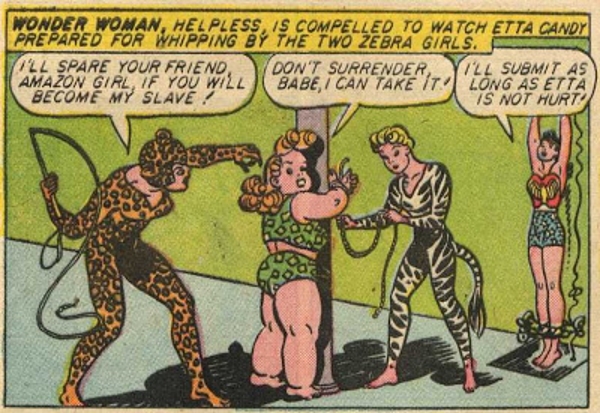
Still weird. And even more weird, they’re all barefoot. Wonder Woman is barefoot more than any other comic book hero short of Dolphin and Metamorpho. Why?
Princess Diana is thus a lot of contradictory tropes. These have been drawn on in different proportions and rewritten endlessly as part of Wonder Woman’s constant updating. Then, it gets taken back to the original.
For example, the Pygmalion idea of Diana as a statue come to life was rewritten. There were two statues, one white and one black and both were brought to life, wait for the conflict and a general introduction of black Amazons (not impossible ion the myth). Then that was changed too.
Now, Diana is the product of natural (?) procreation and her father is Zeus. She is the daughter of a married man who had sex with her mother. That also doesn’t get mentioned much, either. She learned war from Ares, god of war. Hell of a CV, either of them. She breaks with him. Again, we’re back to the dichotomy between love and war which has been the overriding dynamic of the character.
This is part of the need to ground Wonder Woman not in the real world but in the views of womanhood we now have. And that goes back to the original stories.
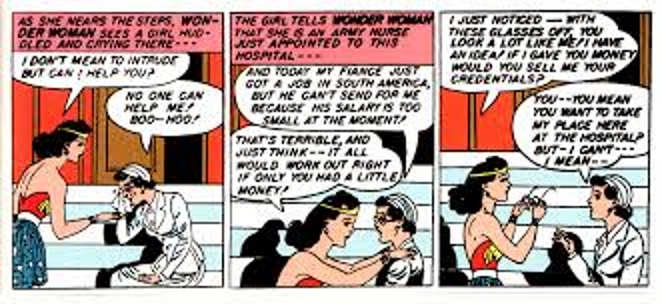
The most important thing here is Princess Diana wore glasses to take on her disguise as Diana Prince.
By the way, is there a reason “Diana Prince” sounds so much like “Diana Palmer” – the then girlfriend and later wife of the Phantom?
Princess Diana came to America and put on a costume which embodied American values. She was a kind of female Captain America in that. This has been hard to explain in later years, but she came out in World War II. The object was to get every possible ally to join the allies and to get every person in those allies to support the cause of the war.
After the war this became a lot less popular. They still have trouble dealing with it. Princess Diana was meant to have arrived in the sixties or later, so the World War II thing had to be shunted. While the war was on, though, it worked perfectly. Now, in the movie she is immortal and came to our society in World War I. Steve Trevor died long ago and Hollywood never could deal with an active, stable relationship. And, again, no Nazis which sell really badly as toys so make it World War I.
But the costume was brief for the times. People complained, not about the legs or the cleavage, but showing her back. People also complained about her general attractiveness. There were very few superheroines before Wonder Woman. They were fully dressed: bodysuits, business suits, evening dresses – Phantom Lady was the exception.
People complained about how cute and exposed she was and the comic replied. The complainants were old women and a man tells them they just wish they were as pretty as Wonder Woman.
Any reason they wouldn’t be when they were young? They appear to be at least in their seventies so. This bit appeared in the 1940s, so they would have been born in the 1870s. Things had changed and Wonder Woman was meant to mark that kind of change. And stepping from an old to a new world, she embodied contradictions as in that example.
Ever since, writers and artists have veered between showing Wonder Woman as desirable and desiring her as being shallow. In seventy years – the approximate age of the old women in the comic – we have not gotten past that issue.
Wonder Woman’s powers were defined in the same way as the original and true Captain Marvel. She had strength of Hercules granted by Hercules and later by Demeter; the speed of Mercury granted by Mercury (same god but under his Greek name, Hermes); wisdom of Athena granted by that goddess (Captain Marvel got the same power from Solomon); and great beauty granted by Aphrodite. Looking good is her super power, and sometimes her writers seem ashamed of that.
In the same way, Steve Trevor is the man she loves. He asks her to marry him. She says she will when all evil is removed in the world. Later that was changed to if she married him, she would have to pretend to be less capable than she really is to keep him happy, and no woman should have to do that.
But in the comics Steve Trevor never tried to make Wonder Woman be less than she really was. Quite the opposite. He has always been written as supporting her and accepting he loved a woman with super powers and a duty to the world.
Somebody had a message to pass and they did so. After all, the original message was no longer valid in a turbulent society. Just as Wonder Woman shifted back and forth between attractive and independent. She went between loving Steve Trevor to not needing and therefor not wanting him.
Both sides underlie the character and they switch from one to the other, depending on the themes they’re playing with. The same goes with when she is paired with Superman, who is clearly ‘good enough’ for her. To make the coupling somehow more reasonable, her powers were upgraded to match his downgraded powers.
This makes sense because when she was created, Wonder Woman was supposed to be as powerful as Superman. However, that was early flying Superman who was not nearly as powerful as he would later be.
After Steve Trevor ceased to be a suitable love interest, DC has never found another one. They haven’t tried all that much. Part of the reason was the fact Wonder Woman was a soldier, now she is a warrior.
Originally, Wonder Woman came to America fighting unfairness in American society. Originally fighting for equality for women, after a few months she started talking about tolerance and not judging people by race. She also fought Nazis, as you do. She was a soldier.
She also broke the law as a reconnaissance soldier would do. Princess Diana came to America without papers. By coincidence she met a nurse named Diana Prince. Princess Diana paid Diana Prince, buying her papers so Diana Prince could go off and join her boyfriend in South America without any papers of her own. She would never be seen or heard from again.
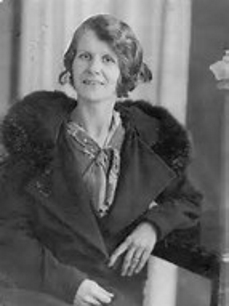
This is Mrs. Marston, who also contributed to what Wonder Woman is.
One of those “women hidden in the background” things
Princess Diana became a nurse and later got changed into a lieutenant in the US military, a lower rank than Steve Trevor. She would continue in those dual roles, though in the Justice Society of America, she was relegated to non-fighting role of secretary. Unconsciously her role for women was at least partly justified by that.
After the war everybody was sick of the war. Part of that was a new love of science fiction (the future) and dislike of superheroes (you can’t change the world by yourself). Quite simply, no superheroes meant the future that was inevitable was safe.
Wonder Woman fell back on her mythical origin, not her military self. She returned to Paradise Island. Her stories were wrapped around herself, her mother, and her younger selves when she was a girl (Wonder Girl) and a toddler (Wonder Tot). She ceased to be mythical and became a fairy tale.
It did not last long because it sold badly. She was saved from this because in the end her dynamic is between myth and military, being good enough on her own and joining with another. It’s not a coincidence that Power Girl will choose whom she wants to be with tonight and Wonder Woman looks for a lifelong mate.
Wonder Woman was returned to being soldier for many years, failed when they made her an ordinary woman, and more recently has been dipping heavily in any Greek-Roman mythology that will fit into the story. Gods, Minotaurs, and the lot tried in various configurations.
Also a thong.
Marston only wrote the first eight issues of the comic. But his initial influences are still critical to the character. And there’s one more aspect that shows this. It’s a matter of truth. Wonder Woman holds the lasso of truth and there is no hooking up when you know and reveal the inner self to another. Her creator had two long term, live-in relationships, not a wife and some one-night stands. Where did he get the lasso of truth when that has no parallel in myth? Like the bracelets Wonder Woman wears, he took it from his own life and reconstructed it to fit the story.

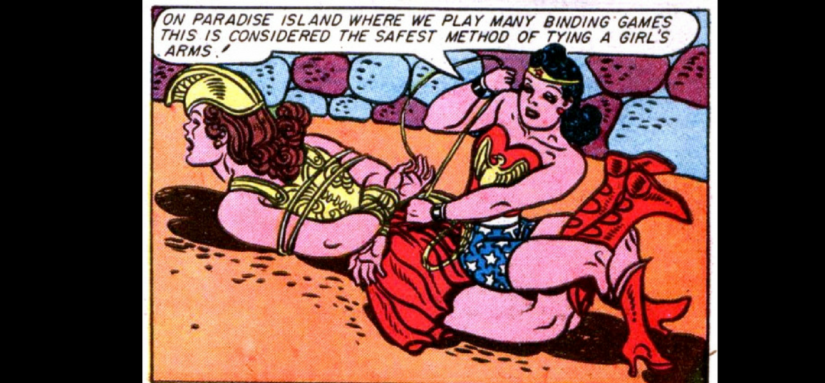
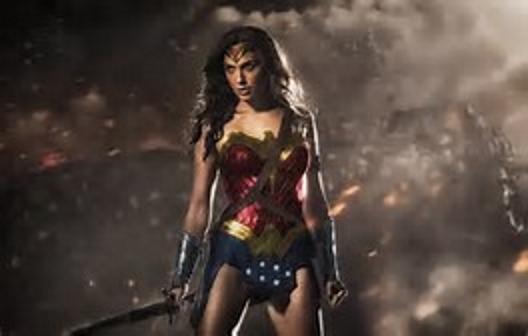
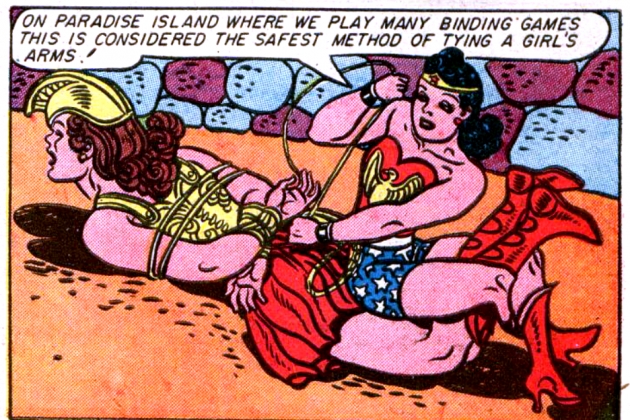

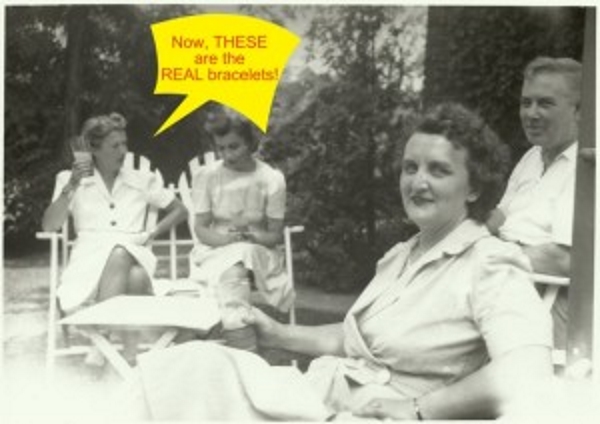
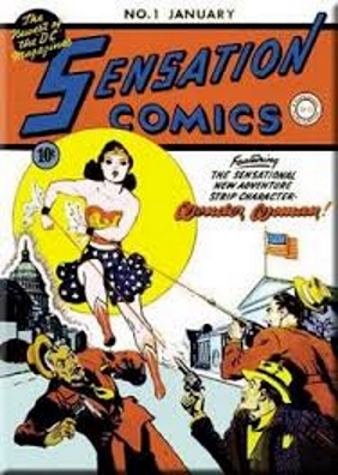
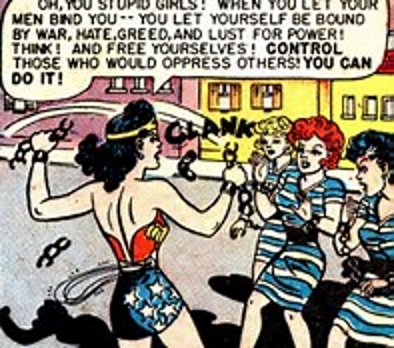
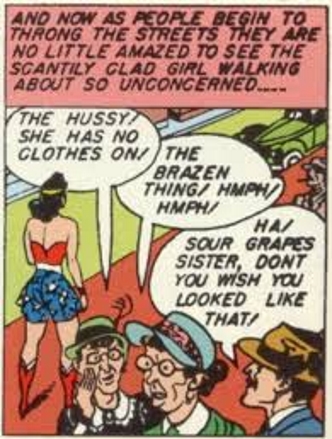
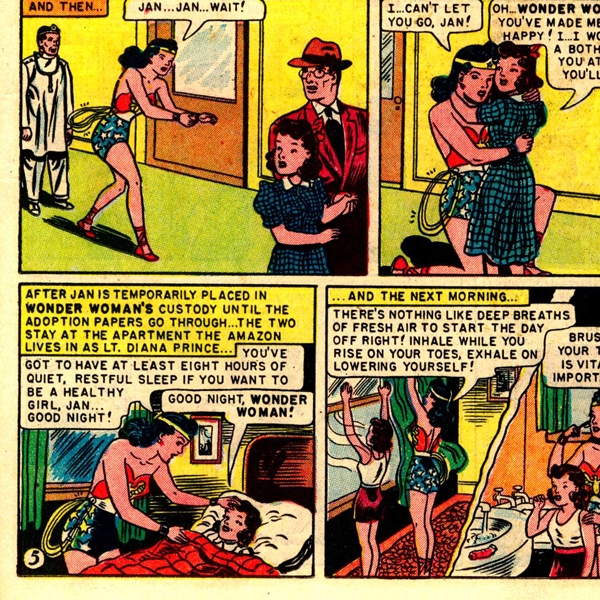
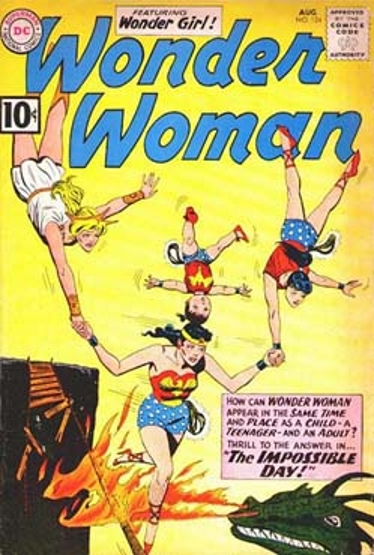
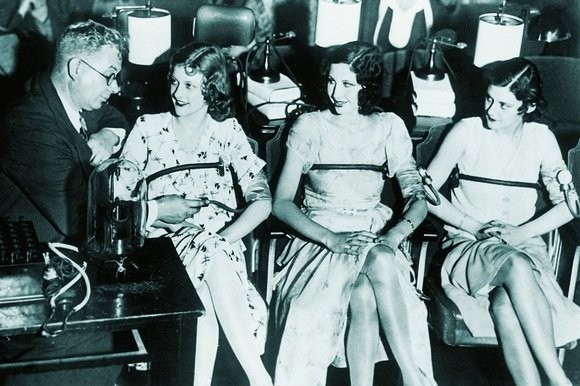
Comments are closed.